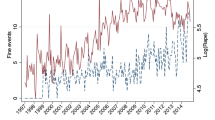Abstract
Following the highly publicized insanity acquittal of John Hinckley in 1982, legislators throughout the country attempted to reform the insanity defense. At the time, policy makers had virtually no empirical evidence with which to guide their reforms. The focus of this research is to determine if more informed policy-making would be possible today? Results show that more states are able to identify cases involving an insanity acquittal than during the 1980's and provide annual data on the number of rate of insanity acquittals. The data collected by many of the states have significant limitation.
Similar content being viewed by others
REFERENCES
Blau, G. L., & Pasewark, R. A. (1994). Statutory changes and the insanity defense: Seeking the perfect insane person. Law and Psychology Review, 18, 69–108.
Center for State Courts. (1996). Examining the work of state courts, 1996: Supplement to examining the work of state courts. Williamsburg, VA: Author.
Heinbecker, P. (1986). Two years' experience under Utah's mens rea insanity law. Bulletin of the American Academy of Psychiatry and Law, 14, 185–191.
Janofsky, J. S., Vandewalle, M. B., & Rappaport, J. R. (1989). Defendants pleading insanity: An analysis of outcome. Bulletin of the American Academy of Psychiatry and Law, 17, 203–210.
McGinley, H., & Pasewark, R. (1989). National survey of the frequency and success of insanity pleas and alternative pleas. Journal of Psychiatry and Law, 17, 205–221.
Pasewark, R., & McGinley, H. (1985). Insanity plea: National survey of frequency and success. Journal of Psychiatry and Law, 13, 101–108.
Perlin, M. L. (1996). Myths, realities, and the political world: The anthropology of insanity defense attitudes. Bulletin of the American Academy of Psychiatry and Law, 24, 5–26.
Silver, E., Cirincione, C., & Steadman, H. J. (1994). Demythologizing inaccurate perceptions of the insanity defense. Law and Human Behavior, 18, 63–70.
Steadman, H. J., McGreevy, M. A., Morrissey, J. P., Callahan, L. A., Robbins, P. C., & Cirincione, C. (1993). Before and after Hinckley: Evaluating insanity defense reform. New York: Guilford.
Zonana, H. V., Wells, J. A., & Getz, M. A. (1990). Part I. The NGRI Registry: Initial analyses of data collected on Connecticut insanity acquittees. Bulletin of the American Academy of Psychiatry and the Law, 18, 115–128.
Author information
Authors and Affiliations
About this article
Cite this article
Cirincione, C., Jacobs, C. Identifying Insanity Acquittals: Is It Any Easier?. Law Hum Behav 23, 487–497 (1999). https://doi.org/10.1023/A:1022316216470
Issue Date:
DOI: https://doi.org/10.1023/A:1022316216470




